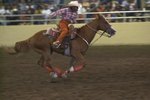Things You'll Need
Saddle
Computer with internet access
Western saddles have been in use in the United States since the 19th century. Determining the age of a western horse saddle can be a challenge. Even experts often have difficulty dating some of the older and more obscure saddles. If your saddle is more than 20 years old, you may only be able to figure out an approximate age or date of its origins. There are several aspects of the saddle that you can use to determine an approximate age.
Identifying a Recently Manufactured Saddle
Find the serial/model number. Newer saddles have the model or serial number stamped onto a plate or flap underneath the flap of leather that covers where the saddle skirting meets the fender (sometimes called a jockey).
Determine the saddle's manufacturer. Look for the manufacturer's name and logo to be stamped in plain sight on the saddle. Check on the back, the skirts or on a plate underneath the jockey.
Contact the saddle's manufacturer for information about the saddle's age. Most manufacturers will be able to tell you the age of the saddle using the serial number.
Go online and research the saddle manufacturer in conjunction with your serial number. Research information about the line of saddles, including when they were produced or how to decode them. This may be necessary if the manufacturer is no longer in business.
Determining the Age of Hard to Identify Saddles
Locate any identifying marks or logos on the saddle. Look for any type of brand, logo or name stamped anywhere on the saddle.
Research any identifying marks or brands online to determine the manufacturer. Compare the saddle with existing products and older products to determine what line the saddle is from and obtain its approximate age.
Determine its general style (barrel saddle, roping saddle, cutting saddle) and compare it to saddles with which you have information. For example, if you know it is a cutting saddle, perform an online search for cutting saddles and look for similar saddles. If you can find another one like it, you may be able to determine where it came from and its approximate vintage.
Thoroughly evaluate the saddle or have a saddle expert evaluate the saddle, if you lack experience. Determine the age and origin by studying styling details and the cut of the skirts.
Tips
No-brand saddles do exist and are virtually impossible to trace. The older ones may have been made by a small-time saddle maker. The newer ones are typically low-quality saddles manufactured assembly-line style overseas somewhere and sold at a low cost. The serial or model number on saddles manufactured after 1990 will almost always have the date of manufacture coded into the serial number. Some manufacturers, such as Circle Y, provide a decoder for their serial numbers online. Some obscure brands or saddle makers still have websites dedicated to their products or collectors of their products that may help you pinpoint the saddle's origins. If the saddle is made using any kind of synthetic materials (not leather) it was more than likely manufactured in the last 10 to 20 years. The heavier and more well-worn a saddle is, the older.
References
Photo Credits
-
Joe Raedle/Getty Images News/Getty Images
Writer Bio
Jen Davis has been writing since 2004. She has served as a newspaper reporter and her freelance articles have appeared in magazines such as "Horses Incorporated," "The Paisley Pony" and "Alabama Living." Davis earned her Bachelor of Arts in communication with a concentration in journalism from Berry College in Rome, Ga.





